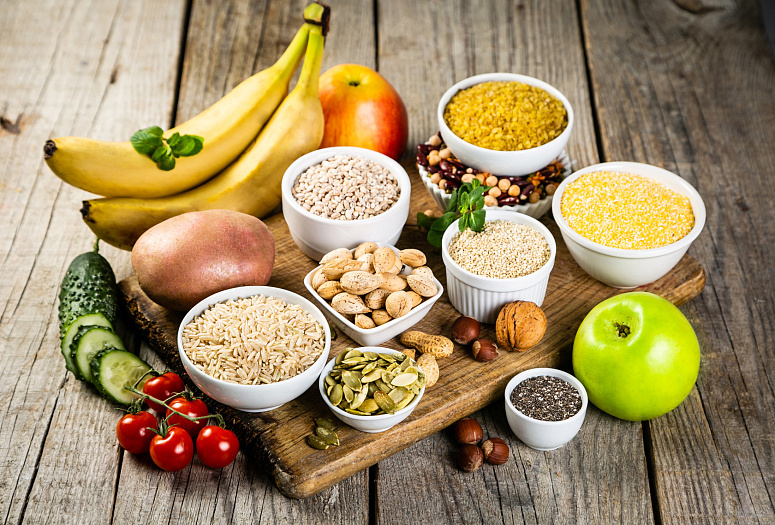When we think of "taste", we immediately imagine flavors dancing on our tongues. But in Ayurveda, taste (rasa) goes deeper—it's how food communicates with our body, influences our emotions, and even shapes our cravings. Of the six Ayurvedic tastes (sweet, sour, salty, bitter, pungent, and astringent), sweet stands first—not just for its comforting flavor, but as the most nourishing and grounding of all. This is why ancient texts list tastes in order of their life-sustaining power, with sweet leading the way.
Sweet taste in Ayurveda: Qualities and effects
According to Ayurvedic principles, every taste emerges from elemental alchemy:
- Sweet = Earth + Water (building, nourishing);
- Sour = Fire + Earth (stimulating, heating);
- Salty = Water + Fire (hydrating, mineralizing);
- Bitter = Ether + Air (detoxifying, lightening);
- Pungent = Fire + Air (metabolizing, cleansing);
- Astringent = Earth + Air (toning, absorbing).
The sweet taste in Ayurveda manifests these essential elemental qualities:
- Cooling – reduces body heat and inflammation;
- Grounding – provides stable and sustaining energy;
- Moisturizing – maintains hydration and internal lubrication;
- Mildly cohesive – gently binds and integrates tissues;
- Systemically nourishing – supports all bodily tissues;
- Revitalizing – restores both physical and mental energy;
- Deeply satiating – fulfills nutritional and emotional needs;
- Anabolic – promotes tissue growth and repair.
As the sweet taste combines the earth and water elements, it directly influences the doshas:
- Increases Kapha (earth + water dominance);
- Decreases Vata (counteracts ether + air);
- Reduces Pitta (moderates fire + water).
Despite these effects, the sweet taste remains essential for all doshic constitutions due to its deeply nourishing qualities. Pitta types benefit most from a moderate intake, Vata thrives on balanced amounts, while Kapha should consume it in minimal quantities.
Beyond sugar: Hidden sources of natural sweetness
While conventional wisdom associates sweetness primarily with fruits, honey, and sweeteners, Ayurvedic wisdom offers a more expansive perspective on this essential taste.
Discover nature's bounty of sacred sweetness through these nourishing foods:
- Grains: Wheat, rice, and barley.
- Legumes: Red lentils, mung dal, and peas.
- Vegetables: Cooked: Potatoes, carrots, beets, and cauliflower; Fresh: Bell peppers, cucumbers, and sweet tomato varieties.
- Fruits: Dates, figs, grapes, bananas, melons, prunes, and dried fruits.
- Nuts & seeds: Almonds, cashews, coconut, pumpkin seeds, and walnuts.
- Dairy: Butter, ghee, and fresh cream.
- Herbs & spices: Basil, vanilla, cardamom, licorice root, cinnamon, nutmeg, peppermint, cumin, dill, fennel, saffron, and tarragon.
- Natural sweeteners: Honey, sugar, and alternative sweeteners.
In Ayurveda's elegant dance of tastes, bitter emerges as sweet’s perfect counterbalance. Yet mysteriously, certain foods like licorice root weave both these opposing flavors into one harmonious essence.
Digestive journey of sweet foods
The miraculous digestive journey begins the instant food meets your tongue. Like a master conductor, your taste buds interpret each flavor note, sending complex nutritional data straight to your brain's processing center. This brilliant biological computer then analyzes the macronutrient symphony - proteins, fats, and carbohydrates - and composes the perfect enzymatic response for complete assimilation of life-giving nourishment.
Robert Svoboda’s Prakriti: Your Ayurvedic Constitution illuminates this through the orange’s dual nature: "For this experiment, slice an orange in half and savor the first portion.
Next, take a spoonful of something sweet—honey or maple syrup—then taste the second half. No matter how sweet the first piece tasted, the second will now seem remarkably more sour. The orange hasn’t changed—your perception has. That initial sweetness satisfied your body’s immediate craving, so when the second half meets your tongue, it no longer prioritizes sweetness. Instead, it reveals the orange’s bright acidity—the flavor your system now seeks."
Three universal laws of food’s impact on the body
First factor – Rasa: The immediate effect begins in the mouth with Rasa (taste perception). Here, we focus on the sweet taste’s primal impact.
Second Factor – Virya: During digestion, the sweet taste exhibits a cooling energy. Digesting it demands additional metabolic resources—drawn from other bodily systems—temporarily reducing their activity. This explains why the sweet taste particularly balances Pitta dosha.
Third Factor – Vipaka: After complete digestion, sweet foods leave a sweet post-digestive effect, according to Ayurveda.
Digestive influence of the sweet taste:
- Tissue nourishment: From birth, actively builds and strengthens all seven bodily tissues through inherent compatibility;
- Life-stage support: Especially vital for growing children and rejuvenating elders;
- Healing power: Accelerates tissue repair and recovery from physical trauma;
- Beauty & vitality: Enhances skin radiance, hair strength, sensory acuity, and cultivates ojas (the body’s supreme vitality);
- Nurturing qualities: Maintains healthy body composition, soothes the throat, and enriches breast milk production;
- Longevity aid: Supports healthy aging and amplifies prana (vital life energy);
- Protective action: Neutralizes internal toxins (ama) and buffers environmental stressors;
- Emotional balance: Elicits deep tranquillity, emotional satisfaction, and inner bliss (ananda);
- Neurological harmony: Stabilizes cognitive function and supports nervous system balance.
Adverse effects of overconsumption:
- Drowsiness and apathy;
- Indigestion and bloating;
- Parasitic infections;
- Loss of muscle tone, obesity, and diabetes;
- Poor circulation;
- Eye inflammation;
- Excessive mucus (including respiratory congestion);
- Complacency and greed;
- Addictive tendencies.
The Ashtanga Hridaya Samhita describes sweet taste thus: "It coats and moistens the oral mucosa bringing physical comfort and sensory delight..."
Sweetness and the senses: How taste transforms perception
Beyond physical effects, tastes directly impact emotions and awareness. Sweetness provides satiety and contentment—yet, when overused, it can foster complacency and greed.
In Ayurveda, sweet taste—like bitter and astringent—has a cooling and constricting quality. These emotions inhibit new desires; complacency, for instance, reduces craving for sensory pleasures.
Conversely, sour, salty, and pungent tastes are heating and expansive, driving insatiable cravings for food, activity, and stimulation.
Sweet enhances Kapha’s self-sufficiency, cools Pitta’s anger, and calms Vata’s anxiety. Yet it also most readily creates unhealthy attachments, often used to compensate for emotional dissatisfaction.
Ayurveda cautions against processed foods with refined sweetness – including commercial candies, pastries, cookies, dairy-based desserts, and other packaged treats loaded with artificial additives, food dyes, and preservatives. These products obstruct the body's subtle channels, quickly causing negative effects from excess consumption: fostering dependency, creating addictive patterns, and numbing one's appreciation for whole, natural foods.
Nature offers us abundant, wholesome sweetness through grains, legumes, and fruits. Explore nourishing alternatives!


